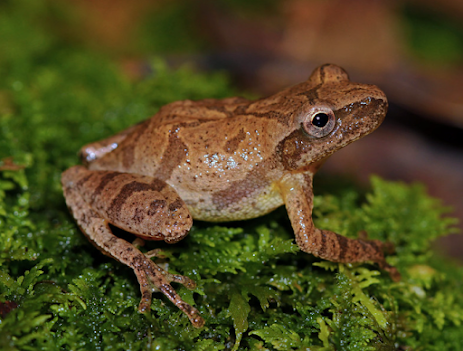The Sounds of Spring
I don't realize how quiet Winter is until Spring comes around. As I'm writing this I just saw 2 bald eagles flying in my backyard. When I go on walks with my dog, he tries to chase all the squirrels and robins he sees hopping along the ground- we saw a particular robin yesterday pull an earthworm out of the ground and eat it. But regardless of the birds which have always been a good indicator for me of Spring approaching, and the sound of yard equipment or people out and about after a long winter, the frogs seem to know the weather better. Last evening we listened to Spring Peepers and it truly felt like the first day of Spring.
Image of a Spring Peeper
Spring peepers are found throughout the Eastern U.S., going as far South as central Florida and as far North as James Bay in Canada, stopping at their Western line around Minnesota to East Texas. They prefer habitats of wet woodlands, by pools and still waters so they can lay their eggs in the Spring. These vernal pools dry up in the Summer but are shallow and warm up fast in the Spring; which makes them perfect for mating and laying eggs in (sometimes up to 1,200!). Spring peepers in particular come out of their soft muddy 'dens', under logs or whatever else they find to be a suitable shelter they have spent the winter hibernating in when it warms up around April in the UP. They can hibernate due to the natural antifreeze in their blood. Studies have determined that nighttime temperatures around 40 degrees F stirs the Spring Peepers to action.
They congregate in breeding pools during this time. You know they are around due to their evening mating call that blasts a peeping sound around 20 times a minute and much louder than any song bird! The males actually climb up natural structures so their call can be heard farther distances to attract their choicest mate. After females lay their eggs in the vernal pools and males fertilize them- depending on the temperature- tadpoles can hatch as soon as two days to two weeks.
Image of a vernal pool
Adults feed in the evening right before all this action takes place, the younger ones have to forage in the mornings and afternoons- I suspect to not get in the way of the adults. They are insectivores meaning they eat primarily buys like spiders, beetles, ants and whatever else they can catch. They are also prey to a lot of animals like birds, mammals, reptiles and more. When they are tadpoles they are most vulnerable being prey to things like spiders, leeches and dragonflies. Tadpoles, not being the best hunters yet, eat algae and microscopic organisms until they get older.
Coloration on a Spring Peeper
Having so many predators it is important that Spring Peepers display cryptic coloration. At about 1 inch long and weighting 0.1 to 0.2 oz. they certainly aren't very big or eye catching. I have heard it described as they are roughly the length of a paper clip. They are tiny and hard to spot since they blend in with the trees, leaves, and mud around these vernal pools. They are generally tan in color with and 'X' shape of dark bands on their back and some other dark bands and patterns can be seen to fill in the empty spots. Shades of course range in their coloration but all blend into their habitat very well. They have a short life span of 3-4 years, so again, blending in is of utmost importance.
Another vernal pool
Besides predation, habitat loss is a threat to Spring Peepers and other frogs around the globe. Wetlands are sometimes drained for agriculture, developed for urbanization, infested with invasive species that crowd out the native ones or polluted without the pausing realization that a lot of life centers around these areas. The worst pollution was delt with after Rachel Carson's book Silent Spring, when they realized pollution had a whole ecological impact that was bioaccumulated in frogs and smaller animals and then larger animals. There is still pollution now, but more common in the form of littering or fertilizer run off than a widespread pesticide craze like in the book. Protecting habitat is vitally important to continue hearing the sounds of Spring.
*All images from Flickr*






.png)
Comments
Post a Comment